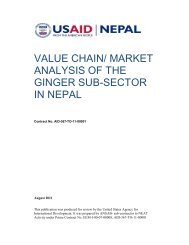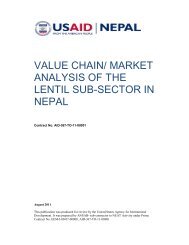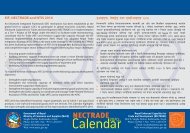value chain/ market analysis of the orthodox tea sub ... - Nepal Trade
value chain/ market analysis of the orthodox tea sub ... - Nepal Trade
value chain/ market analysis of the orthodox tea sub ... - Nepal Trade
Create successful ePaper yourself
Turn your PDF publications into a flip-book with our unique Google optimized e-Paper software.
The low availability <strong>of</strong> green leaf is one <strong>of</strong> <strong>the</strong> reasons why most <strong>of</strong> <strong>the</strong> factories are runningbelow capacity. Despite <strong>the</strong> good production <strong>of</strong> green leaf in <strong>the</strong> some rural parts such asTehrathum, and Panchthar, <strong>the</strong> leaves are unable to reach factories due to a lack <strong>of</strong> anadequate transportation infrastructure. From rural communities, green leaf is carried byhumans or on <strong>the</strong> backs <strong>of</strong> animals which limits <strong>the</strong> amount <strong>of</strong> quality leaf that can reach aspecific factory.2.1.3 Cost <strong>of</strong> ProductionThe cost <strong>of</strong> production (COP) in <strong>orthodox</strong> <strong>tea</strong> depends on farming methods, productivity <strong>of</strong>soil, input costs, labor costs, overhead, and o<strong>the</strong>r financial variables. Farmers are generallynot sure <strong>of</strong> <strong>the</strong> COP and very <strong>of</strong>ten <strong>the</strong> financial costs are not taken into account. This resultsin a <strong>sub</strong>-standard level <strong>of</strong> knowledge in pricing methods.The cost <strong>of</strong> production can be divided into conventional and organic. The conventionalmethod yields higher productivity compared to organic due to <strong>the</strong> use <strong>of</strong> chemical fertilizersand pesticides. As per a report completed by <strong>the</strong> Ne<strong>the</strong>rlands Development Organization(SNV), <strong>the</strong> cost <strong>of</strong> production <strong>of</strong> green <strong>tea</strong> leaf under <strong>the</strong> conventional cropping methodscomes to around 19.55 NPR/kg based on production yield <strong>of</strong> green leaf to be around 2.75metric tons per year in a land <strong>of</strong> 0.5 ha. In contrast to this, COP <strong>of</strong> green <strong>tea</strong> leaf underorganic cropping methods which has a yield <strong>of</strong> green leaf around 1.35 metric tons per yearper 0.5 ha (while using only non-composted cattle dung) is 52.20 NPR/kg. For organiccropping methods which have a yield <strong>of</strong> 1.75 metric tons per year per 0.5 ha (while usingcattle dung and composts), <strong>the</strong> COP <strong>of</strong> green <strong>tea</strong> leaf is calculated to be 39.43 NPR/kg. Thedetailed cost <strong>of</strong> production was calculated in <strong>the</strong> SNV report and is presented in Annex 9.2.1.4 Distribution <strong>of</strong> Value AdditionThe green leaves provided by farmers are processed in large and small factories located inand around production areas. Based on farming methods, two types <strong>of</strong> <strong>orthodox</strong> green leaf aresupplied by farmers- organic green leaf and conventional green leaf. Organic green leavesare priced higher than <strong>the</strong> conventional leaves. Through discussions with farmers and traders,<strong>the</strong> average price for organic leaf was found to be 40 to 55 NPR per leaf and for conventionalleaves was 20 to 26 NPR per leaf. The price <strong>of</strong> green leaf also differs according to <strong>the</strong> flushand leaf quality. The first flush conventional green leaf had received a price <strong>of</strong> 31 to 43 NPRin some areas.The proceeds received by farmers for <strong>the</strong>ir <strong>tea</strong> leaves are low and in some cases almost equalto production costs. The gross income per household from green leaf varies from place toplace depending on <strong>the</strong> cost <strong>of</strong> production. The farmers who have easy access to resourcessuch as agricultural inputs, transportation, and live near factories have an advantage overthose who are not nearby factories or input providers. With an average plantation area <strong>of</strong> 0.75ha per farmer and productivity <strong>of</strong> 5.5 tons/yr/ha, <strong>the</strong> estimated average gross revenue perhousehold from <strong>the</strong> green leaf comes to around 95,000 NPR per year when <strong>the</strong> average priceis 23 NPR per leaf. It is estimated that 60 percent <strong>of</strong> proceeds are pr<strong>of</strong>ited by farmers afterdeducting costs; however, <strong>the</strong> margin can vary depending upon <strong>the</strong> cost <strong>of</strong> production.During shortage periods, <strong>the</strong> CTC processors come to <strong>the</strong> hills for <strong>the</strong> purchase <strong>of</strong> green leafand <strong>of</strong>fer competitive prices to fulfill <strong>the</strong>ir requirement for raw materials. The price <strong>of</strong><strong>orthodox</strong> green leaves is mostly determined by <strong>the</strong> price received by made <strong>tea</strong> in <strong>the</strong> SiliguriValue Chain/Market Analysis-Orthodox Tea 10






